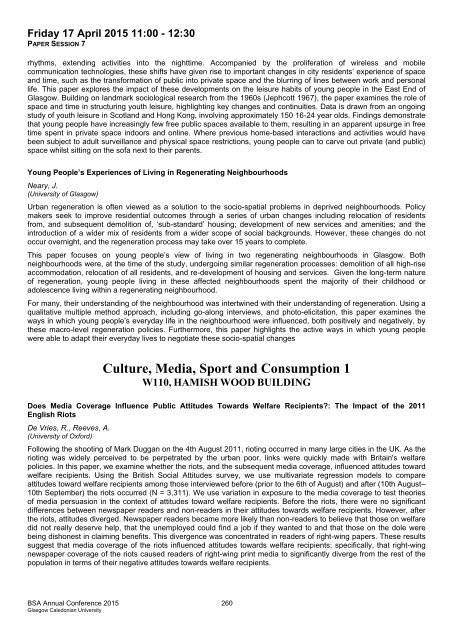Programme full
Programme full
Programme full
You also want an ePaper? Increase the reach of your titles
YUMPU automatically turns print PDFs into web optimized ePapers that Google loves.
Friday 17 April 2015 11:00 - 12:30<br />
PAPER SESSION 7<br />
rhythms, extending activities into the nighttime. Accompanied by the proliferation of wireless and mobile<br />
communication technologies, these shifts have given rise to important changes in city residents’ experience of space<br />
and time, such as the transformation of public into private space and the blurring of lines between work and personal<br />
life. This paper explores the impact of these developments on the leisure habits of young people in the East End of<br />
Glasgow. Building on landmark sociological research from the 1960s (Jephcott 1967), the paper examines the role of<br />
space and time in structuring youth leisure, highlighting key changes and continuities. Data is drawn from an ongoing<br />
study of youth leisure in Scotland and Hong Kong, involving approximately 150 16-24 year olds. Findings demonstrate<br />
that young people have increasingly few free public spaces available to them, resulting in an apparent upsurge in free<br />
time spent in private space indoors and online. Where previous home-based interactions and activities would have<br />
been subject to adult surveillance and physical space restrictions, young people can to carve out private (and public)<br />
space whilst sitting on the sofa next to their parents.<br />
Young People’s Experiences of Living in Regenerating Neighbourhoods<br />
Neary, J.<br />
(University of Glasgow)<br />
Urban regeneration is often viewed as a solution to the socio-spatial problems in deprived neighbourhoods. Policy<br />
makers seek to improve residential outcomes through a series of urban changes including relocation of residents<br />
from, and subsequent demolition of, ‘sub-standard’ housing; development of new services and amenities; and the<br />
introduction of a wider mix of residents from a wider scope of social backgrounds. However, these changes do not<br />
occur overnight, and the regeneration process may take over 15 years to complete.<br />
This paper focuses on young people’s view of living in two regenerating neighbourhoods in Glasgow. Both<br />
neighbourhoods were, at the time of the study, undergoing similar regeneration processes: demolition of all high-rise<br />
accommodation, relocation of all residents, and re-development of housing and services. Given the long-term nature<br />
of regeneration, young people living in these affected neighbourhoods spent the majority of their childhood or<br />
adolescence living within a regenerating neighbourhood.<br />
For many, their understanding of the neighbourhood was intertwined with their understanding of regeneration. Using a<br />
qualitative multiple method approach, including go-along interviews, and photo-elicitation, this paper examines the<br />
ways in which young people’s everyday life in the neighbourhood were influenced, both positively and negatively, by<br />
these macro-level regeneration policies. Furthermore, this paper highlights the active ways in which young people<br />
were able to adapt their everyday lives to negotiate these socio-spatial changes<br />
Culture, Media, Sport and Consumption 1<br />
W110, HAMISH WOOD BUILDING<br />
Does Media Coverage Influence Public Attitudes Towards Welfare Recipients?: The Impact of the 2011<br />
English Riots<br />
De Vries, R., Reeves, A.<br />
(University of Oxford)<br />
Following the shooting of Mark Duggan on the 4th August 2011, rioting occurred in many large cities in the UK. As the<br />
rioting was widely perceived to be perpetrated by the urban poor, links were quickly made with Britain's welfare<br />
policies. In this paper, we examine whether the riots, and the subsequent media coverage, influenced attitudes toward<br />
welfare recipients. Using the British Social Attitudes survey, we use multivariate regression models to compare<br />
attitudes toward welfare recipients among those interviewed before (prior to the 6th of August) and after (10th August–<br />
10th September) the riots occurred (N = 3,311). We use variation in exposure to the media coverage to test theories<br />
of media persuasion in the context of attitudes toward welfare recipients. Before the riots, there were no significant<br />
differences between newspaper readers and non-readers in their attitudes towards welfare recipients. However, after<br />
the riots, attitudes diverged. Newspaper readers became more likely than non-readers to believe that those on welfare<br />
did not really deserve help, that the unemployed could find a job if they wanted to and that those on the dole were<br />
being dishonest in claiming benefits. This divergence was concentrated in readers of right-wing papers. These results<br />
suggest that media coverage of the riots influenced attitudes towards welfare recipients; specifically, that right-wing<br />
newspaper coverage of the riots caused readers of right-wing print media to significantly diverge from the rest of the<br />
population in terms of their negative attitudes towards welfare recipients.<br />
BSA Annual Conference 2015 260<br />
Glasgow Caledonian University


